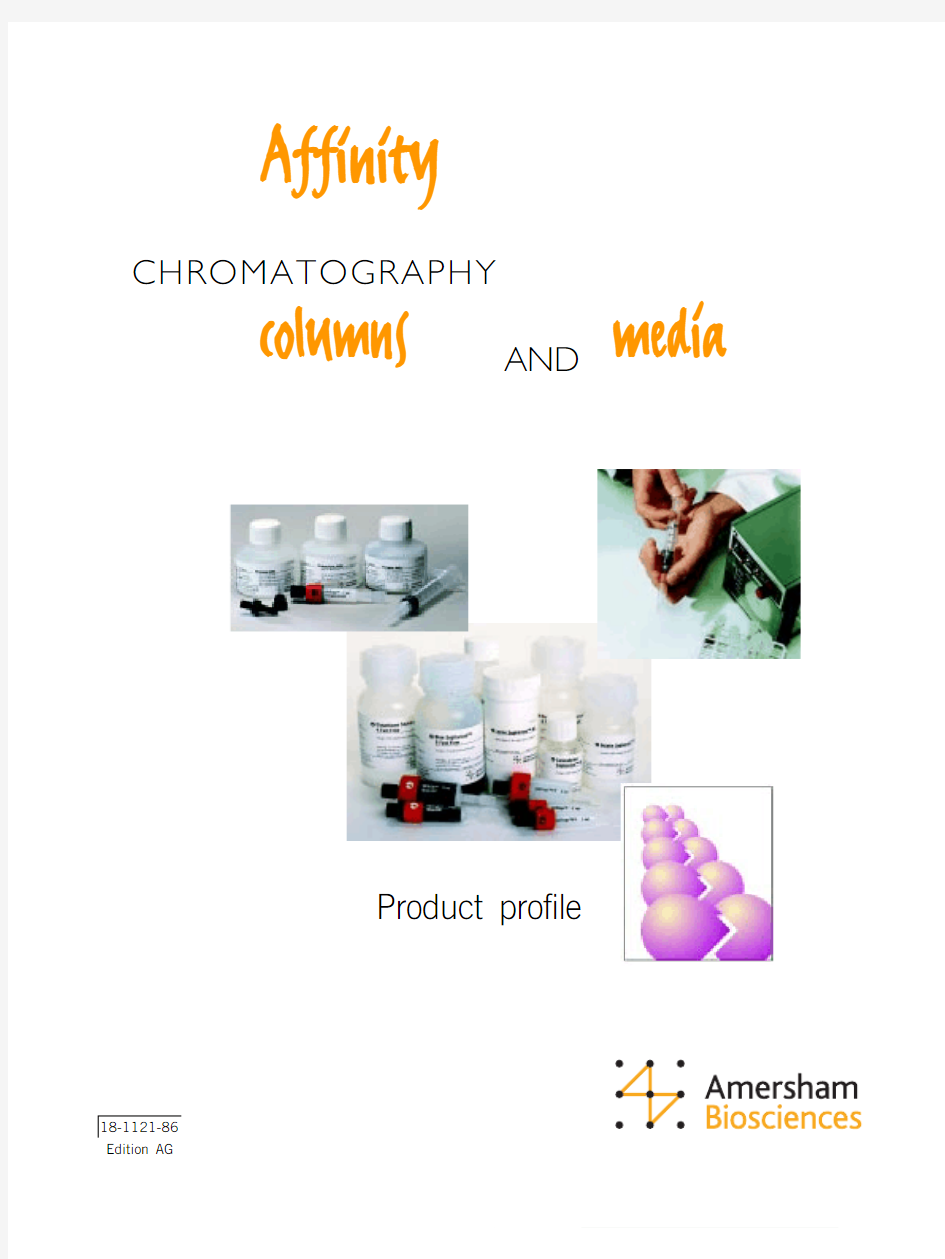亲和层析预装柱和填料选择指南

- 1、下载文档前请自行甄别文档内容的完整性,平台不提供额外的编辑、内容补充、找答案等附加服务。
- 2、"仅部分预览"的文档,不可在线预览部分如存在完整性等问题,可反馈申请退款(可完整预览的文档不适用该条件!)。
- 3、如文档侵犯您的权益,请联系客服反馈,我们会尽快为您处理(人工客服工作时间:9:00-18:30)。
18-1121-86Edition AG
Affinity
CHROMATOGRAPHY
columns AND
media
Product profile
Ordering Information
Affinity Chromatography (AC)
Affinity Chromatography separates proteins on the basis of a reversible interaction between a protein (or group of proteins)and a specific ligand attached to a chromatographic matrix.
Affinity Chromatography can be used whenever a suitable ligand is available.
The target protein(s) is specifically and reversibly bound by a complementary binding substance (ligand). The sample is applied under conditions that favour specific binding to the ligand.
Unbound material is washed away, and the bound target protein is recovered by changing conditions to those favouring desorption.Desorption is performed specifically, using a competitive ligand,or non specifically, by changing the pH, ionic strength or polarity.Proteins are concentrated during binding and collected in a purified, concentrated form. The key stages in a separation are shown in Figure 1.
Affinity Chromatography may also be used to remove specific contaminants, for example Benzamidine Sepharose FF (high sub)removes serine proteases such as trypsin, thrombin and factor Xa,and Blue Sepharose HP removes albumin.
Media selection
Parameters such as scale of purification and commercial availability of affinity matrices should be considered when selecting affinity media.
HiTrap affinity columns are ideal for method optimization or small scale purification of target proteins using well established protocols.
Affinity media can be prepared by coupling a ligand to a selected gel matrix. HiTrap NHS-activated HP is designed specifically to facilitate this process and is supplied with a recommended coupling procedure for coupling primary amines.
For separations of glycoproteins and polysaccharides, media screening may be required to select the correct specificity.
Figure 1. Typical affinity separation.
Immunoglobulins
While protein A and protein G affinity media are similar in many respects, their specificities for IgG differ. Protein G affinity media are the better choice for general purpose capture of antibodies since they bind IgG from a broader range of eukaryotic species and bind more subclasses of IgG. Species-specific examples
include stronger binding of polyclonal IgG from cow, sheep and horse to protein G. Polyclonal rat IgG, human IgG 3 and mouse IgG 1 are bound by protein G but not by protein A. Generally,protein G has greater affinity for IgG and minimal binding of albumin resulting in cleaner preparations and greater yield.Conversely, protein A may be the better choice for isolating certain subclasses of IgG or for removing cross-species IgG contaminants from horse or foetal calf serum, for example.Purification of human and mouse IgM is possible by the use of HiTrap IgM Purification HP 1 ml column. The thiophilic adsorption media with 2-mercaptopyridine coupled to Sepharose HP is designed for one-step purification protocol resulting in 80–95%pure IgM.
Purification of IgY from egg yolk is easily performed using HiTrap IgY Purification HP 5 ml column. The purity is over 70% in one-step using this special designed medium.
Fusion proteins
Expression of fusion proteins is needed when larger quantities of target protein are required for further characterization. We offer products to facilitate every step in this process, from choosing the correct expression system through to selecting the most suitable purification solution for GST and His-tagged proteins.
Purification of a glutathione S-transferase fusion protein is simple, using mild elution conditions that minimize the risk of damage to the functionality of the target protein. The GST-tag is easily detected and can be removed in one-step if required.For routine purification of larger quantities of GST-tagged
proteins, GSTrap FF, prepacked HiTrap 1 ml and 5 ml columns with Glutathione Sepharose 4 FF and HisTrap or HiTrap
Chelating HP , for His-tagged proteins, provide the ideal solution.The columns are compatible with ÄKTAdesign chromatography systems to ensure reproducible results under optimized conditions.
Optimization parameters
1.Select correct specificity for target protein.
2.Follow manufacturer’s recommendations for binding and elution conditions.
3.Select optimum flow rate for sample application to achieve efficient binding.
4.Select optimum flow rate for elution to maximize recovery.
5.Select maximum flow rate for column regeneration to minimize run times.
adsorption of sample and flow through of wash away unbound elute bound
